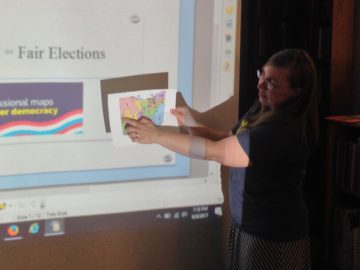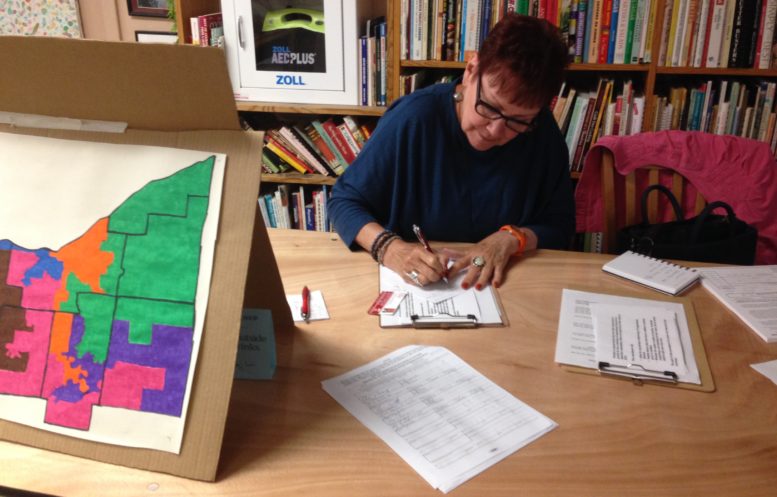By DAVID DUPONT
BG Independent News
In Ohio winning a seat in the U.S. Congress is pretty much a guarantee of lifetime employment thanks to way Congressional districts are drawn.
In the last election, the closest race had the victorious candidate winning by a margin of 36 percentage points. Those wide margins were true whether the candidate was Democratic incumbent Marcy Kaptur in the 9th District sweeping to victory with 69 percent of the vote over Republican Donald Philip Larson, or Republican incumbent Bob Latta trouncing Democratic challenger James Neu Jr. with 70 percent of the vote.

Katelyn Elliott makes a presentation at Grounds for Thought about the need to end gerrymandering.
The problem now, said Katelyn Elliott, a volunteer with an effort to change the way the state’s districts are drawn, is that an incumbent in a safe district has no incentive to listen to or take into consideration the views of voters from the other party. Those districts are the result of gerrymandering mapping district boundaries that assure large majorities for one party.
For the most part that favors the Republicans who hold 12 of the state’s 16 seats in Congress, despite the state being considered a swing state.
That’s probably why the state Democratic Party is supporting with the petition drive by the non-partisan Fair Congressional Districts for Ohio to get a constitutional amendment on the ballot to change the way Congressional Districts are determined. But changing the way districts are drawn has also gained bipartisan support including from Republican Gov. John Kasich.
The amendment has qualified for the ballot, Elliott said. She spoke Thursday at an event to recruit and train people who will circulate petitions.
They’ll need to secure 305,000 statewide. That includes signatures from 44 counties. For a county to count, there must be signatures equal to 5 percent of the vote in that county from the last gubernatorial election, she said.
All those signatures have to be filed by July 5 if the measure is going to appear on this November’s ballot. But if it doesn’t, Elliott said, signatures collected now will still be valid, as long as the signee hasn’t moved, to qualify for the November, 2018 ballot.
Currently the districts are drawn by the state legislature, or rather the majority party members of the state legislature behind closed doors.
Voters in 2015 approved, overwhelmingly with 71 percent of the vote, a change in how state legislative districts are drawn. The same body set up under that amendment would be charged with drawing Congressional districts.
Neither, however, will happen until after the next census in 2020. It could be especially critical then because population trends could cost the state a seat in Congress.
The new plan would assure members of the minority party, Democrats in this case, would have seats at the table and would have to assent to the new map.
That panel includes the governor, auditor, secretary of state and one representative each appointed by the Ohio Senate president, the Speaker of the Ohio House, the Ohio Senate Minority leader, and the Ohio House minority leader.
In order to be approved, Elliott said, at least one member from the minority party has to agree to a districting plan. At this point, no provision is made for representation of minor parties or independent voters, who outnumber members of either party.
The process would also be more transparent, with the various districting plans publicized, hearings held, and methodology explained. Software would be available to allow residents to try their hands at the process, Elliott said.
The idea is to create compact district that keep communities together. No county, for example, could be split into more than two district. Municipalities and townships should be kept whole.
For now petition seekers are spreading out throughout the state to wherever people are gathered to seek signatures. Elliott said though the time is tight, given the support so far for the measure, there is a chance voters could decide the issue in November.



